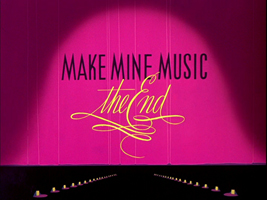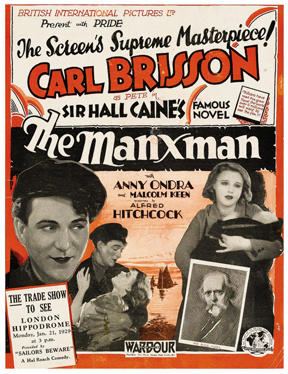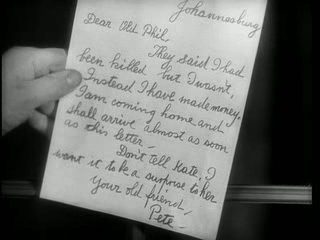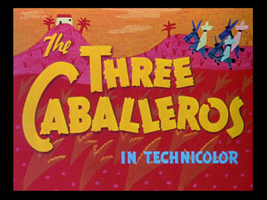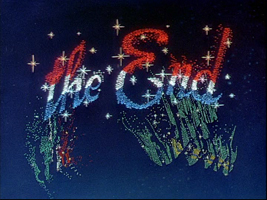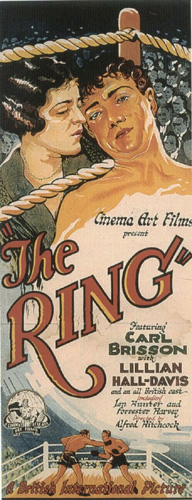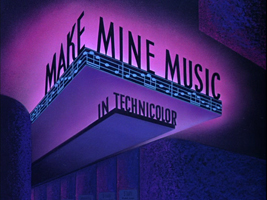
[Somewhat less editing this time. Do we come off as less intelligent as a result? I think so!]
BROOM I think we should start with some general comments and then talk about each section.
BETH Briefly.
BROOM Yes, briefly.
ADAM That was cheerfully stupid but it was still stupid.
BROOM It was pretty stupid.
BETH It was.
ADAM I do not recommend that people see this. I think this was the worst Disney production I’ve ever seen.
BROOM Ever?
ADAM Of all of them, yes.
BETH I saw a bunch of the individual pieces when I was a kid, because The Disney Channel would air them before or after shows, and I think that’s the best way to view them. When they’re all together, you can notice that they don’t really add up to anything and aren’t that great. But by itself, “All The Cats Join In” is a lot of fun.
ADAM A couple of them were more cheerful than stupid, but all of them seemed to have the same quality of being utterly careless.
BROOM I don’t think they were utterly careless, but I do think that the quality of care was lower than anything we’ve seen before. I know, that was already my comment about The Three Caballeros, which now seems undeserved. In fact, I want to add, for the record – I intended to add this when Beth added her opinion…
BETH I never weighed in on The Three Caballeros, but I thought it was great. That’s my official statement.
BROOM – I was going to say that when I watched it a second time with Beth, having come to terms with what it was, I really enjoyed it and appreciated the kind of craft that went into it, because I was no longer taken aback by how the tone of the previous movies wasn’t there. Whereas Make Mine Music seemed genuinely slapdash in exactly that way I described. But “slapdash” isn’t really a fair word to use for any Disney movie. During this movie I was thinking, “what if I went to an animation festival today and saw this?” Almost anything in this movie would make me think, “this is so wonderfully old-fashioned and they’ve done a really good job of it.”
BETH Really? What about “Without You?”
ADAM I don’t think any of these pieces had the inventiveness or fun or creativity of the Oscar-nominated shorts we saw. Not to mention prior Disney movies.
BROOM Last year’s Oscar-nominated shorts? I think most of these were better than the French priest who sells a heaven machine.
ADAM I think it’s reprehensible that they actually marketed this in theaters. It felt like a collection of leavings.
BROOM I think that’s exactly what it was. I know that “Blue Bayou” was cutting-room floor material from Fantasia.
ADAM In the introduction to Janson’s “History of Art” – or whatever my art history book was in high school – they talk about this Greek sculpture of a boy pulling a thorn out of his foot, and how your impression is changed when you realize that on the head, the locks of the hair are not falling down correctly, which indicates that the head was cut off of another statue and stuck on to this new statue. The knowledge of that lack of unity makes you appreciate the work less, in and of itself. And I think that is true here.
BROOM Yes. But I think I would have totally tuned out during “Blue Bayou” if I didn’t have that knowledge of where it came from.
BETH I pretty much did.
BROOM Yeah, I know. All right, let’s talk about them in order.
1. Rustic Ballad: THE MARTINS AND THE COYS
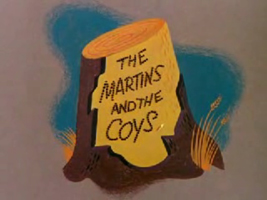
ADAM Worse than Hanna-Barbera.
BETH No! That’s not true.
BROOM I don’t think that’s fair at all. I thought the color design was appealing, as in other sequences as well. I thought the characters glowed nicely when they went to heaven. I thought the silhouettes in the square-dancing scene were well done.
BETH I also thought the square-dancing scene was good. I thought the music in that scene was very strong.
BROOM I thought there was a certain atmosphere to that indoor scene that was not worthless.
ADAM I guess it had a crude vigor, and it was a much better first number than “Blue Bayou,” which would have been a horrible way to start the movie.
BROOM Thoughts about its being censored? [ed: This segment has been cut in its entirety from the DVD release. We watched it on Youtube.]
ADAM Well, it is offensive, on several levels.
BETH I was not offended by it.
ADAM It consists of nothing but stereotypes.
BROOM I don’t imagine the hillbilly constituency is actually that threatening to Disney.
ADAM Really? There was an incident a couple years ago where the first lady of West Virginia complained about – I forget exactly what the medium was, but there was some project where every state was represented by a little cartoon, and West Virginia was represented by an outhouse. And there was a hue and cry.
BROOM Okay, but it’s not like this was called “A Tale of West Virginia.” It was just about hillbillies. They exist in –
ADAM They exist in about six states.
BROOM They exist as a stereotype independent of reality. To say where in reality that stereotype falls becomes offensive. I guess they were the Hatfields and the McCoys. But the real Hatfields and McCoys actually killed each other; I don’t think we have to show respect for them.
ADAM Whatever. It was fine. I didn’t think the caricature was especially interesting. They all looked exactly the same.
BROOM The character designs were ugly and dumb.
ADAM On purpose, I guess. It was ugly to look at. And the humor was not that funny.
BROOM I found a common problem of many of the segments to be that, unlike Fantasia, where there were no words, here the songs narrated the action. Doing that in a way that doesn’t make everything seem obvious and stupid because it’s redundant with the visuals… is hard.
BETH I thought that “The Whale Who Wanted to Sing at the Met” did that in an effective and funny way.
BROOM But in this first one, when they sang, “and then they went to heaven! and then they shot some more!…” and then you saw them doing exactly that, it seemed a little… [smacks forehead].
ADAM A problem that I have with country music is that of all genres of popular music, it is the one that is expressly narrative in almost all cases. And that is not good. Songs should not be expressly narrative.
BROOM You think there shouldn’t be ballad songs, period?
ADAM It’s very hard to do them well, and they work best when they’re somehow over the top, as the whale one was. This one was just straightforwardly narrative and uninteresting.
BROOM Thinking back, that was the thing that made those first two sequences in Three Caballeros seem particularly dumb – the penguin bit and the gauchito bit: they were narrated as they happened, which always makes things seem clumsy. The redundancy of a narrator describing animated action makes both halves seem pointless. “Why do we have to watch it if he’s describing it? And why does he have to describe it if we’re watching it?” I think it’s almost always a mistake and I don’t know why they didn’t realize that.
BETH Let’s move on.
2. Tone Poem: BLUE BAYOU
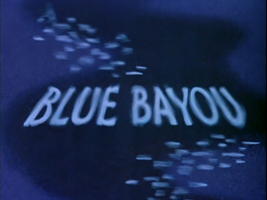
ADAM Terrible! Terrible.
BETH That was the dullest animated thing I’ve seen in a long time.
ADAM Almost no visual interest of any kind.
BROOM When the water was sparkling and you saw the moon reflected in it, that was okay. But it didn’t have anything to do with the music, in this version, because it was animated to something else. [ed: Debussy’s Clair de Lune]
BETH Whatever. It was bad.
BROOM I remember it being unsatisfying on the Fantasia bonus disc in that other form, too. But here it was really unsatisfying.
BETH The song was bad.
ADAM It had none of the “right ring and left ring” appeal of Fantasia. In Fantasia there might have been one thing happening in the middle, but there would also be curlicues around the sides that made you feel that they cared about it.
BROOM Yes, here you were just looking at animation of a stork. It was a stork, right? [ed: a heron]
ADAM Or a pelican maybe.
BETH I don’t think it was a pelican.
ADAM I don’t know. Not really.
BROOM A wading bird.
3. Jazz Interlude: ALL THE CATS JOIN IN
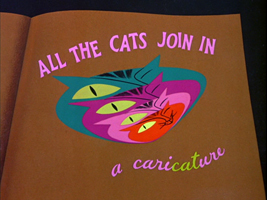
BROOM I saw this on TV once, and I didn’t know what the source was, and I thought, “Really? Disney made this? It’s so cool!” And I still think it’s cool. The animation is not the cleanest they ever did, and the faces are all dumb-looking, but it makes you think about what it was like to be a teenager in the 40s, what “fun” was like in the 40s, and it makes a pretty convincing case.
ADAM I don’t know that that was really what it was like to have fun in the 40s.
BETH It’s an idealized version.
BROOM It’s a fantasy.
ADAM It has sort of a “Peach Pit” quality.
BROOM What does that mean?
BETH From 90210?
ADAM Yeah. Actually, that’s not what I mean. What I mean is – what was the hangout from Saved By the Bell?
BETH I don’t remember. [ed: “The Max”]
ADAM Well, that. It had sort of that feel. And everyone’s face looked like a Raisinet. But it was okay. And at least there was some sort of secondary action, with the little sister.
BROOM It was a relief, because it didn’t have narration, just music, and suddenly the movie felt alive. And the music was actually good, because it was Benny Goodman playing jazz.
ADAM It was definitely the toe-tappingest of the musical numbers.
BROOM I thought the wit of the drawing pencil was well done, and I liked that it was a part of this idea of fun.
ADAM When was Harold and the Purple Crayon created?
BROOM I don’t know. Crockett Johnson. [ed: 1955]
ADAM I think it’s a great concept; it’s always been a great concept, and it was here too.
BROOM I thought it was cool when he didn’t have time to draw the back wheel of the car, so he drew a stop sign to give himself a chance to catch up with them.
ADAM It was good. Yes.
BROOM There’s a slightly sexist quality to the whole thing, but what are you going to do.
ADAM As with all of them.
BROOM Like when the girl gets drawn with too big a butt, and the guy won’t dance with her, and she gets pissed off at god.
BETH That’s funny!
ADAM Or when they leave the girl with the books behind. She’s the only teenager who doesn’t get to join in the fun.
BROOM The only cat who doesn’t join in.
ADAM She’s no cat.
BROOM And also, most pointedly, when the girl is naked for no reason.
ADAM That would never fly today.
BROOM There’s a prurient quality to that. Undisguised prurience.
4. Ballad in Blue: WITHOUT YOU
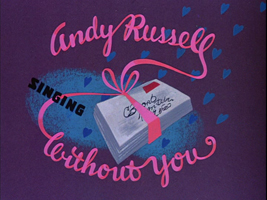
BETH I really liked the rain on the window, but aside from that I thought this was boring.
BROOM I thought the trees and the wavy shadows looked like Salvador Dalí, which might not even be a coincidence, because I know he was hanging around the Disney studios in the 40s. And I thought that was kind of cool.
BETH Eh. I think you’re attributing more to it than it deserves.
ADAM I thought the rain was the only thing they had going at all, and they overdid it.
BROOM You didn’t think it was cool when there were silhouetted trees on the horizon and they were sort of wavery?
ADAM It had an unnecessarily static quality that nothing in Fantasia has. Everything in Fantasia feels ripply and alive, and this was just like, “Here’s a tree.” “We’re slowly panning back through the window.” “Nothing is moving.”
BROOM It had a sort of creepy quality to it that I enjoyed. I thought the design was interesting and a new look for them. I’m surprised at you, Beth, because I thought that it had a “feel” in the way that you like things to have a feel. And yet you didn’t get anything out of it.
BETH I do like things to have a feel, but I didn’t feel like this had a feel.
BROOM I thought it was kind of a classy little number, and it was short.
ADAM It was short.
5. Musical Recitation: CASEY AT THE BAT
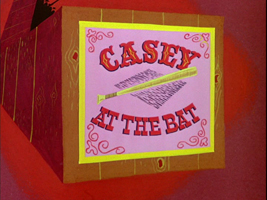
ADAM Why did the faces of all the people in this movie – with the exception of the kids in the “Cats” segment – have this weird working-class leery-scowly bubble-nosed quality?
BROOM I know! It’s a thing that will remain in Disney movies for quite a while. I imagine it’s due to some particular animator. But this was definitely the first time we were seeing it in one of their features. I associate it with an Irish caricature.
BETH It is an Irish caricature. I thought that maybe bow on the umpire’s arm had something to do with Irish heritage, but I’m not sure.
ADAM Maybe. And they do have specifically Irish names in the poem.
BROOM And the guy – Jerry Colonna – is doing Irish voices for a lot of them. It’s like everyone in the story is Irish.
BETH Yes, they all seemed to be Irish.
BROOM It’ll keep coming back; Tweedledum and Tweedledee in Alice in Wonderland, which is coming up, are the same thing. They’re like leering, honking Irishmen.
BETH I liked some of the images in this one.
BROOM You were giggling at it, which surprised me because it was so cornball.
BETH It was really lame. But funny.
ADAM A weird choice to take an established poem and interlace it with songs and other stuff.
BROOM I think the other stuff was to justify its fitting into this “musical concert.” Make mine MUSIC. We didn’t talk about the fact that there was, oddly, a title song to this movie. “Make mine music and the world will sing with you,” or whatever.
BETH Right. It was stupid.
BROOM And a program book opening at the beginning. “Casey at the Bat” was supposed to be manic and funny, like a Goofy cartoon, but it got a little confused. There was a lot of action and a lot of noise, and I didn’t always know what was happening, or why.
ADAM It was at least competent. It looked like solid Disney-style animation. They didn’t get carried away with artsy-fartsy pretension.
BROOM But if things are going to be mediocre, I think artsy-fartsy is more interesting to watch. I found the dumbness of this segment a little numbing.
ADAM That’s because you’re, like, an animation class alum.
BROOM All right, all right. Maybe that’s pretentious of me. I just found myself getting bored during “Casey at the Bat.”
ADAM I didn’t say you’re pretentious. I’m saying that you are more interested in technical variation than other people.
BETH You were bored with the tale of “Casey”?
BROOM No, with the visual. What do you guys think? Do you think it was a good “for-all-time” visualization of the poem “Casey at the Bat?”
ADAM No.
BETH No.
ADAM At first I was dismayed when it was just still images, and I thought, “This is going to be told entirely in stills.” Again, it was like they were scrimping on movement.
BETH I liked that.
BROOM I liked those stills. They were in a style that surprised me.
BETH I thought those seemed to have been given more care.
BROOM They had that turn-of-the-century atmosphere; I liked that. And then when the characters showed up, the Tweedledum faces sort of took away from that atmosphere. I liked all of the period touches. I liked when they said “the band is playing somewhere” and they showed a little town band in a gazebo, which is exactly what it should be.
6. Ballade Ballet: TWO SILHOUETTES
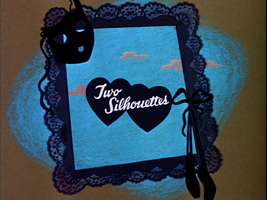
BETH Oh god, “Two Silhouettes.”
ADAM It was terrible, but at least they thought they had a neat idea, unlike in “Blue Bayou.”
BROOM This was a technical exercise that I took no pleasure in. It was the same impulse as “Let’s make Donald dance with a real live woman!” and then the entire sequence ends up being about that.
BETH If you’re going to trace live dancers, the dance that you have them do should involve a lot of movement!
BROOM That was the Disney people once again reaching out for high, high beauty.
ADAM It had all the ponderous sentimentality of animation, but none of the spontaneity.
BETH Well, that’s why they added those cupids, because they needed something.
ADAM Something to look at in the 90 percent of the frame that was not the silhouettes.
BROOM The technical concept demands that they do something with it that they couldn’t do with live action. You could just film silhouettes – I’m sure there’s a way of doing it with lighting. So the point of tracing it should have to be that, like, you put sparkles in their hands, or make them be batting at a cupid. But they hardly had them do anything. Also, beautiful graceful movements in humans are so much less graceful than what you can do with animation that their actual little footsteps end up looking weird and awkward.
ADAM Yes. When she was bobbling along and you could see her feet moving, you thought, “Oh. This actually isn’t as graceful as a cartoon.”
BROOM They could have had her fly around –
ADAM They did, briefly.
BROOM They just had her rise up. But since they could have made her sprout wings, everything she did seemed weighty, which is the opposite of what ballet is supposed to be, so it doesn’t work. The idea doesn’t work.
ADAM By the way, in “Without You” – just going back for a second – I thought, when they showed the star behind the cloud, because there was something in the song about a star, it was the most grudging sort of alliteration, if you will, of image to sense, as to be positively negative.
BROOM I didn’t find that at all. I found the stylization of that one interesting. But we’ve already agreed to disagree.
7. Fairy Tale with Music: PETER AND THE WOLF
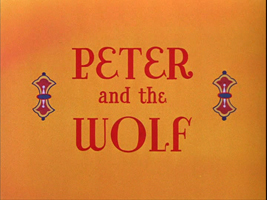
BROOM The narration really killed it. And this one seemed like it had been directed to work without narration, with all attention on the music, and that then someone, after the fact, had said, “we’ve got to have some narration; get Sterling Holloway in here.” And then they recorded him saying, “Uh-oh, Peter!” “Ohhhh no.” “This looks bad!”
BETH I think you’re right.
BROOM Not that it was probably great to begin with, but with the narration it was particularly lame.
ADAM It seemed instructional.
BROOM Well, the piece is supposed to be for learning about the instruments of the orchestra.
BETH The wolf was nice and scary, and that shot of him growling at the beginning was fun. I enjoyed that.
BROOM I liked when the instruments turned into silhouettes at the beginning, before the actual story started.
BETH I liked that part too.
ADAM This version is most people’s experience of “Peter and the Wolf,” is it not?
BROOM I guess. I don’t know.
BETH Mine was a record.
BROOM That’s the proper way to do it.
ADAM It was fine.
BROOM I thought it was pretty dumb. Of course the duck can’t die in this version.
ADAM The duck and the cat and the bird were ugly to look at, and not charming, and had no personalities.
BROOM And in the narration, they all had names, which is another reason it seemed after-the-fact. The animals don’t have names! Why should they have names? “Oh, Sasha!”
BETH Sasha and Sonia.
ADAM And Ivan.
BROOM There was no tension in the storytelling so you didn’t care what was happening. You couldn’t care about the music because he was talking over all of it. And you couldn’t care about the characters because most of them were badly designed. So it was just dumb. And it goes on a long time, because it has to.
BETH Yeah, it got boring.
8. AFTER YOU’VE GONE
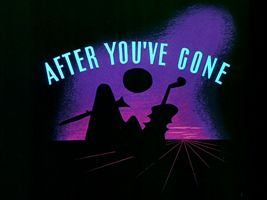
BETH What was this?
BROOM A little jazz bit, where the clarinet and his buddies went on a journey of surreal discovery.
BETH It was fine.
ADAM It was okay. I have nothing to say about it.
BROOM I liked it!
BETH I liked it, but it was not memorable.
BROOM I liked that it was like, “Let’s do a bunch of that stuff from Fantasia again,” but it was a little bit…
BETH Looser?
BROOM Loosey-goosey-er. I liked when there were those floating circles from Fischinger movies, but the clarinet is jumping on them from one to the other. And then a string of colors comes in and it jumps on that, and then a keyboard – it was all the standard ideas that you associate with “animated musical fantasia,” but just sort of thrown together stupidly. I enjoyed how stupid the sequence of events was, and the color scheme was bright and stupid, and I enjoyed that too. And the music was better than a lot of the other ones.
BETH Yeah, the music was good.
BROOM And it was so super-short that I don’t know how you could not enjoy it.
BETH Yeah.
ADAM Yep.
9. Love Story: JOHNNIE FEDORA AND ALICE BLUEBONNET
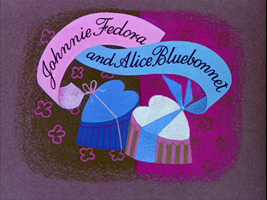
ADAM Sung by the Andrews Sisters.
BETH Now that was stupid.
BROOM You didn’t enjoy that??
ADAM This is actually when I started to perk up again.
BROOM I think they saved the two they thought were best for last. It seemed like the last two were meant to be their strongest.
BETH It was fine. It was stupid, but in a cute way.
ADAM I expected to hate it, but I actually giggled a couple times.
BROOM I thought all the design was actually kind of nice. And I liked the sense you get of the city, and of the period – although it was kind of the same period again. Why were there two turn-of-the-century pieces in this same movie? But I liked it, in a silly way. It was a little like when Mary Poppins goes into the sidewalk painting.
ADAM You know what it was exactly like? There is a Disney short, which I believe is also narrated by that same guy, Sterling Holloway, about a new car, and the car goes through various travails, and then it gets put out on the street, but then it gets bought by a teenager who lovingly restores it.
BETH I think I know what you’re talking about.
BROOM They’re both like The Little House.
ADAM What’s The Little House?
BROOM Virginia Lee Burton children’s book; there’s a little house and the city grows up around it and it gets sadder and sadder, and then it gets trucked out to the countryside to start a new life.
ADAM I’ve seen that, right.
BROOM And I think Disney even made a movie out of that, too. [ed: ALSO narrated by Sterling Holloway!]
ADAM In terms of Disney cartoons, this seemed expressly like the little car one.
BROOM It’s a standard Disney formula. You anthropomorphize a thing, and then the world is rough to it.
ADAM It gets shabbier and shabbier but then it achieves happiness at the end.
BROOM It was an odd choice that Alice couldn’t make any expression with her eyes.
ADAM It was like an early Botox fantasy.
BROOM It was cute that they ended up on horses.
ADAM I didn’t see that coming. It’s nice that in her period of dotage, she didn’t get as battered as he did.
BROOM Anything to say about seeing New York?
BETH I really enjoyed that.
ADAM I liked that it was explicitly New York, and not just some Gotham.
BETH I liked that they showed the Brooklyn Bridge.
10. Opera Pathetique: THE WHALE WHO WANTED TO SING AT THE MET
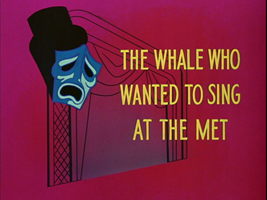
BETH It was good.
ADAM Iconic, even.
BROOM So you had heard of it?
ADAM I think maybe you had mentioned it. Even though it was absurd, it was clearly the standout piece. Although the ending was a total cop-out. Having him get harpooned at the end was just like saying “it was all a dream.” It absolved them from having to come up with any story; just a collection of silly images. But they were funny silly images.
BROOM I thought the high point of this entire movie was when the whale sings “Mama’s Little Baby Loves Shortnin’ Bread.”
ADAM When I was a kid, I used to sing that song all the time. I cannot imagine where I heard it, but it was in my small repertoire of American popular songs.
BETH Looney Tunes, probably.
ADAM Yeah, probably. I didn’t realize it was quite so Negro as it is.
BROOM It wasn’t done that way here; that’s just what it is.
ADAM Sure it was! “Little chilluns?”
BROOM Oh, that’s right.
BETH That was funny.
BROOM I didn’t like seeing his uvulas-slash-vocal-cords. They were just supposed to represent his different voices; they didn’t need to be jiggling stalactites.
ADAM They leaned on that pretty heavily. And at the end, he dies and he goes to heaven, and that’s the end of the movie? What?
BROOM Yeah, it was a little harsh. After the harpoon was shot, I just thought he was going to say something like “I will never fit in in the human world,” and then we’d see him serenading the seals. I don’t understand why he had to die. A martyr to the misunderstandings of opera-house managers.
ADAM Because they couldn’t work out a way to end it in a way that was on time and under budget.
BROOM The moral seemed to be: “He was a miracle, and people don’t always understand miracles.” Maybe there’s a lesson for all of us, there… about a certain miracle that not everyone has accepted into their hearts….
ADAM Really? I didn’t take it that way.
BETH I don’t think so!
BROOM I’m joking!
ADAM Disney cartoons are almost uniformly secular, in a way that I am glad about.
BROOM We all snickered when in “Without You,” when the lyrics said something about “when I pray,” and suddenly that secular cathedral thing appeared. The same shape from “Ave Maria” in Fantasia. There were a lot of things dredged up from the previous movies here.
ADAM This might be a lower point even than the late-70s trough that we’re all familiar with.
BETH It just doesn’t even seem like a movie.
BROOM That’s fair, but I think when we actually get to Oliver & Company you’ll see how much lower the standards can really go.
ADAM I guess I’ve never seen those, so I’ll find out then.
BROOM I think we really have to recognize that the high standard set by Dumbo and Pinocchio is not going to be met, even by the good movies coming up. Cinderella is just not going to be as good as those movies.
ADAM In that sense, the story of the Disney movies is much like the story of Johnnie Fedora. Shiny and new, and then scuffed, and then restored to brilliance at the very end.
BROOM Or is it? On a horse! With holes cut in it!
ADAM I think Aladdin is as good as Dumbo. Well, not as good as Dumbo, but it’s as good as Snow White. And I think The Little Mermaid is as good as those.
BROOM I don’t know about that. Maybe you have to measure their ambition against the possibilities of their own era. It seems like the ambition of Snow White compared to 1937 is grander than anything that was accomplished in the 90s.
ADAM Right, but as has been the case throughout, and as presumably will continue to be the case, ambition is a metric that you use more than we use. On all of these.
BROOM Do you think it’s inappropriate?
ADAM No, it’s just different. I’m seeing these less as artifacts and more as discrete entertainments.
BROOM Well, this movie was certainly far less entertaining than any of the previous ones. I have the least inclination to watch any of it again. Although I would watch the “Cats” segment if it was on, and I would also watch “After You’ve Gone,” I don’t know why you guys didn’t enjoy that one more.
BETH Sorry.
ADAM So, best and worst for everyone?
BETH Best: “Whale.” Worst: “Bayou.”
BROOM I think, best: “All Cats,” and worst: I guess “Blue Bayou.” But I feel like what’s the point of even complaining about it? It was so short. “Peter and the Wolf” was the one I was most disappointed with. I was the most uncomfortable.
BETH But which was the worst?
BROOM “Blue Bayou.”
BETH That was the question. [ed: but I’d now like to change my vote to “Two Silhouettes.”]
ADAM I will also say best was “Cats,” because come to think of it, I think of my affection for the whale one is just for the conceit of the title. Once you decide you’re going to make an animated short called “The Whale Who Wanted to Sing at the Met,” a lot of it follows naturally from the concept.
BROOM The visual of it being gigumbus in the opera house was funny. With a stupid little wig on.
ADAM And then being ginormous in Tristan and Isolde, and then being giant in Mefistofele.
BROOM And which is the worst? Feel free to knock the one I said I liked.
ADAM It’s either “Blue Bayou” or “Without You.”
BETH I might change it so that “Cats” is my favorite too. Because it is actually my favorite, I just wasn’t thinking about it. That’s always been my favorite, but I’d never seen the whale one before, so it made more of an impression on me just now.
[after reading the New York Times review, linked below]
ADAM That’s about right.
BETH It’s very good.
BROOM I thought it was actually a little more forgiving than you guys were.
BETH Of “Casey at the Bat”?
BROOM Of the whole movie. It’s more forgiving, frankly, than I feel.
BETH You can tell that the reviewer wanted to like it, but it’s still critical.
BROOM He lets it off the hook by saying at the end, “I’m sure Mr. Disney’s standards are higher than this movie he made, so it’s all fine.”
ADAM Is this the same reviewer that we’ve been reading throughout?
BROOM Bosley Crowther? I believe it is. Not sure when he’ll disappear.
ADAM Beth, would you rather be named Bosley Crowther, or Manohla Dargis?
BETH I think Bosley.
